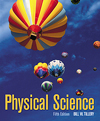Sometimes you can feel the floor of a building shake for a moment when
something heavy is dropped. You can also feel prolonged vibrations in the ground
when a nearby train moves by. The floor of a building and the ground are solids
that transmit vibrations from a disturbance. Vibrations are common in most solids
because the solids are elastic, having a tendency to rebound, or snap back,
after a force or an impact deforms them. Usually you cannot see the vibrations
in a floor or the ground, but you sense they are there because you can feel
them. There are many examples of vibrations that you can see. You can see the
rapid blur of a vibrating guitar string (Figure 6.1). You can see the vibrating
up-and-down movement of a bounced-upon diving board. Both the vibrating guitar
string and the diving board set up a vibrating motion of air that you identify
as a sound. You cannot see the vibrating motion of the air, but you sense it
is there because you hear sounds. There are many kinds of vibrations that you cannot see but can sense. Heat,
as you have learned, is associated with molecular vibrations that are too rapid
and too tiny for your senses to detect other than as an increase in temperature.
Other invisible vibrations include electrons that vibrate, generating spreading
electromagnetic radio waves or visible light. Thus vibrations take place as
an observable motion of objects but are also involved in sound, heat, electricity,
and light. The vibrations involved in all these phenomena are fundamentally
alike in many ways and all involve energy. Therefore, many topics of physical
science are concerned with vibrational motion. In this chapter you will learn
about the nature of vibrations and how they produce waves in general. These
concepts will be applied to sound in this chapter and to electricity, light,
and radio waves in later chapters. |



 2002 McGraw-Hill Higher Education
2002 McGraw-Hill Higher Education